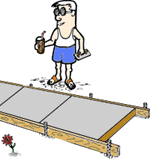|
|
|
|
|
Hot weather concrete tipsUsing and placing concrete during the hot summer months present far different challenges than use and placement during cold weather. The summer month effects of temperature, wind, and air humidity can all have a negative impact on the performance of concrete. For purposes of concrete use and placement, “hot weather" can be defined as any period of high temperature during which special precautions need to be taken to ensure proper handling, placing, finishing and curing of concrete. Hot weather problems are most frequently encountered in the summer, but critical drying factors such as high winds and dry air can occur at any time, especially in arid or tropical climates. Higher temperatures cause water to evaporate from the surface of the concrete at a much faster rate and cement hydration occurs more quickly, causing the concrete to stiffen earlier and improving the chances of plastic cracking occurring. Concrete cracking may result from rapid drops in the temperature of the concrete. This occurs when a concrete slab or wall is placed on a very hot day and which is immediately followed by a cool night. High temperature also accelerates cement hydration and contributes to the potential for cracking in massive concrete structures. Higher relative humidity tends to reduce the effects of high temperature. Other hot weather problems include increased water demand, which raises the water-cement ratio and yield lower potential strength, accelerated slump loss that can cause loss of entrained air, fast setting times requiring more rapid finishing or just lost productivity.The following tips should help you have a successful placement of concrete during hot weather: Organizing/Planning
Pre-placement
Placement
Post-pour
Call us today at 1-800-245-1333, fill out our contact form, or e-mail us at info@deeconcrete.com to locate a distributor near you that carries dee Concrete Accessories high quality concrete forming products. |

Related concrete tips and facts: |
![]()
7350 W. Montrose Avenue • Norridge, IL 60706
Phone: 1-800-245-1333 • Fax: 708-452-7220
Copyright ©1999-2005 dee Concrete Accessories. All rights reserved.